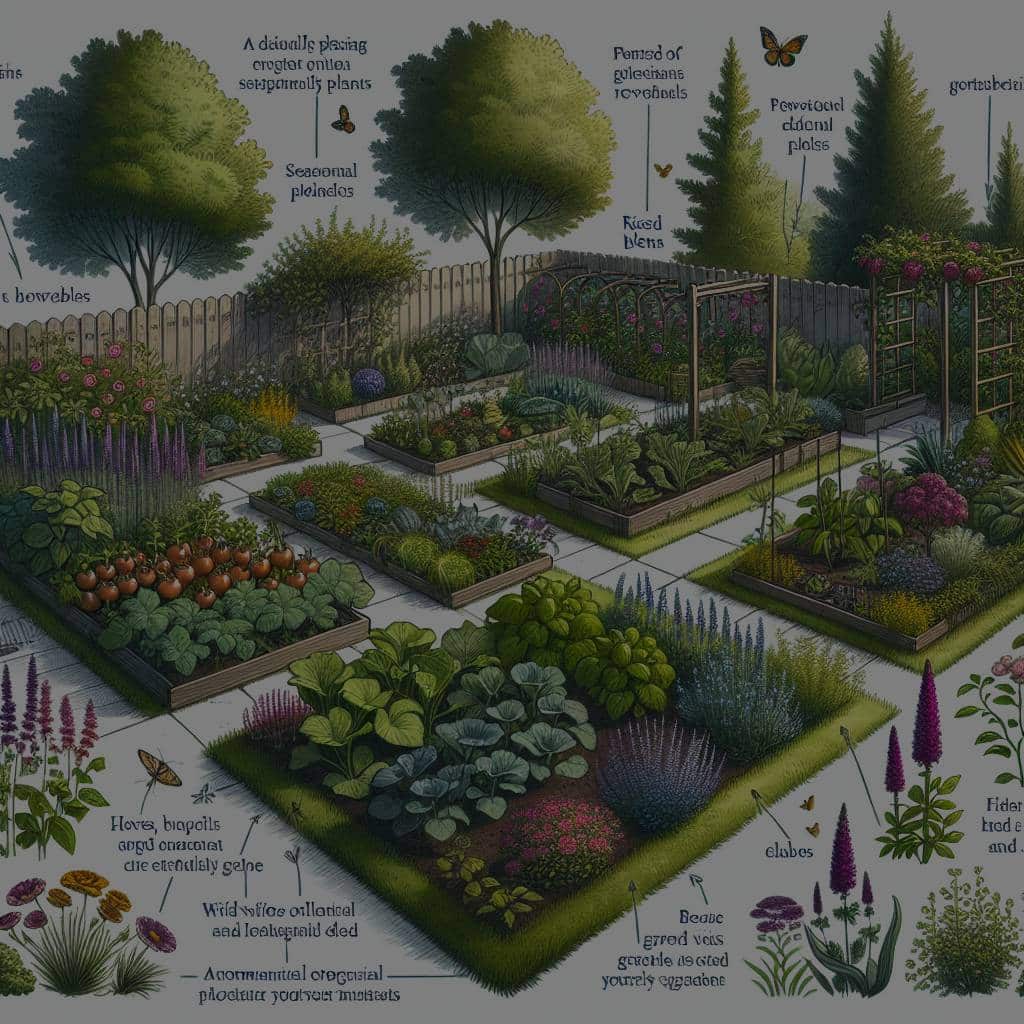How to Plan an Edible Front Yard That’s Both Beautiful and Functional?

The concept of edible landscaping is blossoming with homeowners. It is a sustainable way to integrate food production into your yard while maintaining the aesthetic appeal of your property. You’ve probably thought about growing vegetables in designated areas, like a backyard vegetable plot or in containers on a deck. But have you considered the untapped potential of your front yard? Your front yard can be much more than a conventional landscape. It can be a functional, edible garden where vegetables, fruits, and herbs intermingle with flowers and trees, creating an attractive and productive space. Let’s dive into how you can plan your own.
Why Choose Edible Landscaping?
Firstly, it’s essential to understand why edible landscaping is a valuable endeavor. Unlike traditional landscaping, edible landscaping incorporates edible plants into the aesthetic design of a garden or yard. This practice not only gives you fresh food at your fingertips but also allows you to lower your grocery bills and reduce your carbon footprint. As you grow your food, you will eliminate the need for long-distance transportation and the associated carbon emissions. You will also limit your exposure to commercially grown produce, which often contains pesticides and other chemicals.
En parallèle : What Are the Best Smart Home Devices to Track and Improve Sleep Quality?
Edible landscapes are not just about vegetables, they can also include herbs and fruits, seamlessly integrated with your favorite flowers and shrubs. You’ll have a garden that’s both beautiful and functional.
Choosing the Right Plants for Your Edible Landscape
When choosing what to plant in your edible front yard, you should consider the local climate and soil conditions, as well as the amount of sun and rain your front yard receives. The plants should not only be suited to your local conditions, but they should also complement each other and the overall design of your yard.
A découvrir également : How Can You Create a High-End Home Spa Experience in a Compact Space?
Trees and shrubs often form the backbone of landscape design. In an edible garden, you might incorporate fruit trees or berry bushes into the landscape. For instance, apple trees, pear trees, plum trees, and cherry trees not only provide delicious fruits but also offer shade and attract pollinators. Shorter fruit bushes like raspberries or blueberries can also add color and interest to your yard.
Herbs can be a delightful addition as well. Choose herbs that you enjoy cooking with, such as rosemary, thyme, basil, and parsley. These plants are not only useful but also add a lovely aroma to your yard.
Vegetables can be grown in a multitude of ways: in raised beds, in traditional rows, or interplanted with flowers and shrubs. For an appealing look, consider planting vegetables with colorful fruits or foliage, such as rainbow chard, purple kale or yellow bell peppers.
Designing Your Edible Landscape
Design is a crucial aspect of edible landscaping. A well-designed edible front yard can be just as attractive as a traditional landscape, if not more. You’ll need to consider color, texture, size, and the seasonality of your plants.
For example, leafy greens can provide a soft, feathery texture, while root vegetables like carrots or beetroot can add bursts of color. Consider the growth habit and size of your plants. For instance, indeterminate tomato plants can grow quite large and would be best placed at the back of a garden bed, while smaller plants like lettuce or radishes can fill in the front.
To have a productive garden that looks good year-round, consider the seasonality of your plants. Some plants, such as kale or Brussels sprouts, can withstand frost and provide color and food in the winter months. Meanwhile, plants like tomatoes, peppers, and eggplants thrive in the summer heat.
Maintaining Your Edible Landscape
Once your edible landscape design is in place, the next step is to maintain it. Regular watering, weeding, and pest control are all parts of this process. However, the maintenance of an edible landscape can also be quite rewarding. As you tend to your plants, you’ll watch them grow from seedlings into mature plants that provide delicious food.
One tip for maintaining your edible front yard is to do a little bit each day. Spend a few minutes in the morning or evening watering your plants, pulling weeds, or checking for pests. This regular attention can prevent small problems from becoming big ones and can keep your landscape looking its best.
Embracing Edible Landscaping in Your Neighborhood
Edible front yards are becoming more popular as homeowners recognize their benefits. By growing your own food, you can save money, eat healthier, reduce your carbon footprint, and contribute to your local ecosystem’s resilience.
Remember, your front yard is the first thing visitors see when they arrive at your home. An edible landscape can be a conversation starter and an opportunity to share your love of gardening with your neighbors. You can inspire others to start their own edible landscapes, perhaps leading to a neighborhood filled with lush, productive front yards.
In conclusion, designing and maintaining an edible landscape can be an incredibly rewarding experience. With careful planning, your front yard can be transformed into a beautiful and functional space that provides fresh, homegrown food.
The Role of Ornamental Plants in Your Edible Landscape
When it comes to creating an edible landscape, decorative or ornamental plants also play a crucial role. While the focus may primarily be on edible plants, ornamental ones provide several benefits that boost the overall effectiveness of your edible landscape.
Ornamental plants add an element of visual appeal to your edible landscape. They come in a variety of shapes, sizes, colors, and textures that can be effectively used to create diverse and visually appealing landscape designs. These plants can serve as a backdrop for your edible plants, helping them stand out and catch the eye. For example, the vibrant colors of marigolds or the rich green foliage of hostas can create a stunning contrast with the reds, yellows, or purples of your fruits and vegetables.
Additionally, many ornamental plants can attract beneficial insects that help control the population of harmful pests. For instance, plants like lavender and marigolds are well-known for their ability to attract beneficial insects like ladybugs and bees, which can help in pollination and pest control.
It’s also worth noting that some ornamental plants are edible themselves. For instance, flowering plants like nasturtiums and pansies are not only visually appealing but their flowers can also be used in salads and other culinary creations, adding a splash of color and subtle flavor.
Exploring Creative Landscaping Ideas
As you plan your edible landscape, consider some creative landscaping ideas that will elevate the aesthetics of your front yard while maximizing its functionality. The design possibilities are endless, and you can tailor your edible landscape based on your personal preferences, available space, and local climatic conditions.
Consider using trellises and arches to grow climbing plants like beans, peas, or cucumbers. Not only do these structures provide vertical growing space, but they also add a charming and rustic touch to your garden. Archways adorned with grapevines or passion fruit vines can form a beautiful and edible entrance to your home.
Themed gardens can also be an exciting concept. For instance, you might create a pizza garden by planting tomatoes, basil, oregano, and peppers together. Or, a tea garden could consist of herbs like mint, chamomile, and lemon balm. Having these themed gardens can make harvesting and cooking more fun and can inspire kids to get involved with gardening.
Terraced planting, especially on sloping front yards, can also be a brilliant idea. This can prevent soil erosion while adding an interesting visual element. You can plant different types of plants on each level – perhaps herbs on the top terrace, vegetables in the middle, and fruit trees at the bottom.
Conclusion: The Joy of Creating an Edible Landscape
Creating an edible landscape is not only about growing your own food; it’s a lifestyle choice that integrates sustainability, aesthetics, and functionality into one. Your front yard can become a vibrant ecosystem that not only looks beautiful but also provides fresh and wholesome food.
By embracing edible landscaping, you’re making a statement about your commitment to environmental responsibility. It’s about taking small steps that can collectively make a significant impact on the environment, your health, and your community.
As you embark on your edible landscaping journey, remember to have fun with it. Experiment with different plants, designs, and techniques to find what works best for you. Over time, your edible garden will evolve, and so will your understanding and appreciation of nature.
In the end, an edible landscape is not just about the end product – the ripe fruits, vegetables, or the stunning landscape that you’ve created. It’s also about the joy and satisfaction that come from the entire process – planning, planting, nurturing, and eventually, harvesting. So, get started on your edible landscaping journey, and enjoy the beautiful and bountiful rewards it brings.
